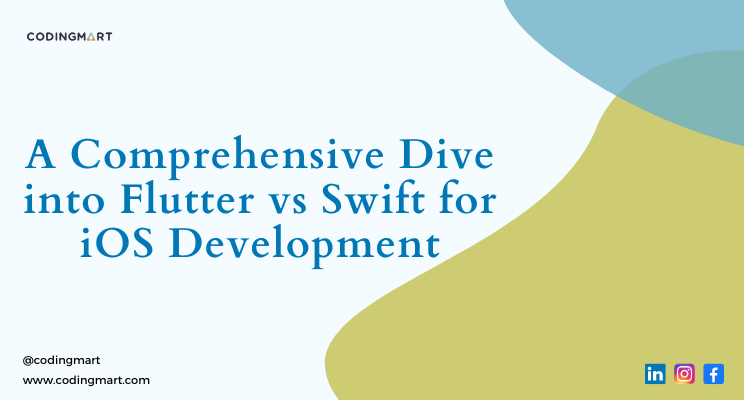blogs
Flutter vs Swift: A Comprehensive Guide for iOS Development

Welcome to this in-depth exploration of the dynamic world of mobile app development, as we unravel the age-old debate surrounding Flutter vs. Swift for iOS development. Whether you’re a seasoned developer seeking new insights or someone venturing into the app creation realm, this detailed comparison aims to provide you with the knowledge necessary to make informed decisions. Let’s embark on this journey!
Understanding the Basics: Flutter and Swift
At the forefront of our discussion is Flutter, an open-source UI toolkit developed by Google. Flutter empowers developers to build natively compiled applications for mobile, web, and desktop—all from a single codebase. Its programming language, Dart, complements a rich set of pre-designed widgets, enhancing the visual appeal of user interfaces.
In the Swift corner, we have Apple’s creation designed exclusively for iOS, macOS, watchOS, and tvOS app development. Swift stands out for its exceptional performance, safety features, and modern syntax, making it a favored choice for iOS developers worldwide.
Common Ground: Cross-Platform Development
Flutter:
- A standout feature of Flutter is its cross-platform compatibility. Developers can utilize a single codebase to create applications for both iOS and Android, effectively reducing development time and effort.
- The Hot Reload feature is a game-changer, allowing developers to instantly witness the impact of code changes, fostering a quicker and more efficient development cycle.
Swift:
- Although Swift is primarily geared towards iOS, it can be employed for macOS development as well. However, achieving true cross-platform development with Swift necessitates additional tools and languages.
UI Design and Customization
Flutter’s strength lies in its customizable widgets, allowing for a high level of UI flexibility. Developers can unleash their creativity to craft unique and visually stunning applications.
With tools like Interface Builder and SwiftUI, Swift simplifies the UI design process, offering a seamless experience for developers to bring their design visions to life.
Ecosystem and Community Support
Flutter benefits from an ever-growing community and a wealth of packages available on pub.dev, solidifying its position as a robust ecosystem.
Backed by Apple, Swift enjoys extensive support from a range of libraries and frameworks, providing developers with a solid foundation for iOS development.
Performance Metrics: Flutter vs. Swift
Flutter:
Hot Reload Efficiency:
Flutter’s Hot Reload feature significantly enhances the development process. It allows developers to make real-time changes to the code and immediately see the results without restarting the entire application. This iterative development approach can boost productivity and contribute to a smoother development experience.
Dart’s Just-In-Time Compilation (JIT) during Development:
Dart, the language behind Flutter, uses Just-In-Time (JIT) compilation during development. This enables dynamic and on-the-fly optimizations, providing developers with a faster feedback loop during the coding phase.
Ahead-Of-Time (AOT) Compilation for Production:
Flutter utilizes Ahead-Of-Time (AOT) compilation for production, translating Dart code into native machine code. This compilation approach contributes to improved runtime performance and reduced application startup times.
Native Performance with Flutter Engine:
Flutter applications use a C++ engine, known as the Flutter Engine, which interacts with the underlying platform’s native code. This setup allows Flutter to achieve native performance, delivering a responsive and seamless user experience.
Swift:
Optimized for iOS Ecosystem:
Swift is tailored specifically for iOS development, optimizing the performance of applications on Apple devices. The language is designed to work seamlessly with Apple’s hardware and software, resulting in efficient and high-performance iOS apps.
Ahead-Of-Time (AOT) Compilation:
Swift employs Ahead-Of-Time (AOT) compilation, translating Swift code into machine code at build time. This compilation strategy enhances the overall performance of Swift applications, especially in terms of execution speed.
Access to Low-Level APIs:
Swift allows developers to access low-level APIs and system frameworks directly, enabling fine-grained control over performance-critical aspects of the application. This level of control is advantageous for developers who prioritize performance optimization.
Integration with Apple’s Ecosystem:
Swift seamlessly integrates with Apple’s ecosystem, including Metal for high-performance graphics rendering. This integration ensures that Swift applications leverage the full potential of Apple’s hardware and software capabilities.
Making the Decision
In conclusion, choosing between Flutter and Swift for iOS development depends on various factors such as project requirements, team expertise, and long-term goals. While Flutter excels in cross-platform development, Swift offers a specialized and optimized environment for iOS app creation.
Remember, there is no one-size-fits-all answer! The best choice is the one that aligns with your project’s unique needs and your team’s skill set.
We invite you to share your thoughts and experiences with Flutter vs. Swift in the comments below. Let’s foster a vibrant discussion!